Protective Packaging Market Size 2024-2028
The protective packaging market size is forecast to increase by USD 6.08 billion, at a CAGR of 3.45% between 2023 and 2028.
Major Market Trends & Insights
- APAC dominated the market and accounted for a 40% growth during the forecast period.
- By the Type - Flexible segment was valued at USD 19.59 billion in 2022
- By the End-user - Food and beverages segment accounted for the largest market revenue share in 2022
Market Size & Forecast
- Market Opportunities: USD 28.41 billion
- Market Future Opportunities: USD 6.08 billion
- CAGR : 3.45%
- APAC: Largest market in 2022
Market Summary
- The market is a significant player in the global industrial landscape, with continuous growth and innovation driving its expansion. According to recent studies, the market is expected to witness a notable increase in demand, with the packaging industry as a whole projected to reach a value of over USD1 trillion by 2025. This growth can be attributed to the increasing focus on product protection during transportation and storage, particularly in sectors such as electronics, pharmaceuticals, and food and beverage. Moreover, advancements in materials science have led to the emergence of novel protective packaging solutions, such as biodegradable and recyclable options.
- These eco-friendly alternatives are gaining traction due to growing consumer awareness and regulatory pressure to reduce waste and minimize environmental impact. In fact, the use of sustainable protective packaging materials is projected to increase at a steady pace, with some estimates suggesting a compound annual growth rate (CAGR) of around 5% between 2020 and 2025. Despite these positive trends, challenges persist, particularly in the areas of cost and complexity. High capital costs associated with the development and implementation of advanced protective packaging technologies can hinder market penetration, especially for small and medium-sized enterprises (SMEs). However, as technology continues to evolve and economies of scale are realized, these barriers are expected to lessen over time.
- In summary, the market is poised for continued growth and innovation, driven by increasing demand for product protection and the emergence of sustainable, eco-friendly solutions. Despite challenges, the market is expected to remain dynamic and evolving, with ongoing research and development efforts aimed at improving performance, reducing costs, and minimizing environmental impact.
What will be the Size of the Protective Packaging Market during the forecast period?
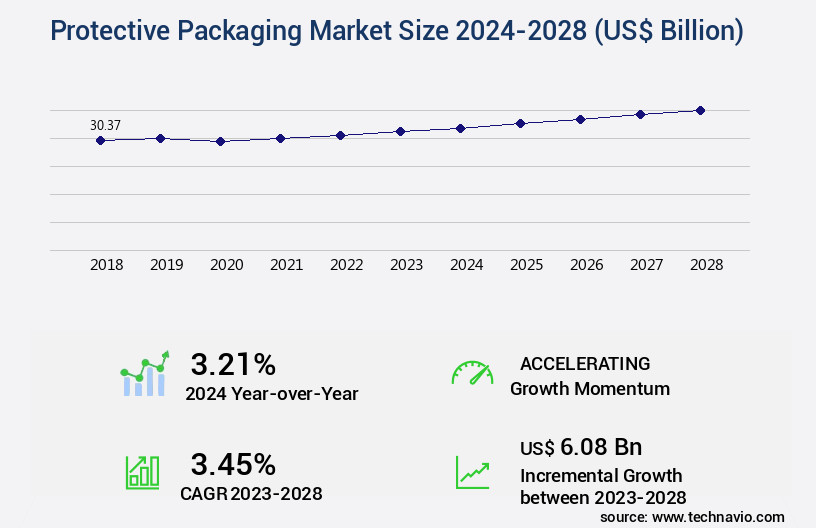
Explore market size, adoption trends, and growth potential for protective packaging market Request Free Sample
- The market encompasses a diverse range of solutions designed to ensure product quality assurance during transportation and storage. Two key areas of focus are structural integrity and sustainability. According to industry estimates, the global market for protective packaging reached USD50 billion in 2020, with an annual growth rate of 4%. Custom packaging designs, such as those incorporating RFID technology and active packaging systems, accounted for 20% of this total. In contrast, biodegradable packaging, a sustainability-focused solution, represented only 5% of the market share. As businesses prioritize supply chain resilience and logistics efficiency, the demand for protective packaging solutions continues to evolve, with a growing emphasis on design for manufacturability, automated packaging machines, and intelligent packaging systems.
- Packaging performance metrics, such as durability and transit damage prevention, remain critical considerations in this market. Additionally, cost analysis and waste management are increasingly important factors as businesses seek to minimize expenses and reduce their environmental footprint.
How is this Protective Packaging Industry segmented?
The protective packaging industry research report provides comprehensive data (region-wise segment analysis), with forecasts and estimates in "USD billion" for the period 2024-2028, as well as historical data from 2018-2022 for the following segments.
- Type
- End-user
- Food and beverages
- Industrial goods
- Consumer electronics
- Household appliances
- Others
- Geography
- North America
- Europe
- APAC
- Rest of World (ROW)
By Type Insights
The flexible segment is estimated to witness significant growth during the forecast period.
In the dynamic and evolving the market, various sectors, including food and beverage, healthcare, personal care, and others, are transitioning from traditional rigid packaging to flexible alternatives. Flexible packaging, characterized by its non-rigid, lightweight, stretchable, and malleable nature, offers numerous advantages. These benefits include improved product protection through moisture and oxygen barrier properties, enhanced supply chain optimization, and the ability to accommodate fragile goods. Furthermore, the push towards sustainable packaging and waste reduction has fueled the demand for protective packaging solutions. Protective cushioning foams, compression strength materials, and vibration damping systems contribute significantly to the market's growth.
The integration of packaging materials such as oxygen barrier films, protective coatings, and pressure-sensitive adhesives ensures product integrity and extends shelf life. Additionally, the adoption of advanced technologies like packaging testing standards, packaging design software, and packaging automation systems streamlines production processes and enhances product quality. The food packaging sector, subject to stringent regulations, is a significant market driver. Humidity-controlled, temperature-sensitive, and UV protection packaging are essential for maintaining product freshness and safety. Moreover, the pharmaceutical industry relies on protective packaging for product security and compliance with regulations. According to recent industry reports, the flexible the market has experienced a significant increase in demand, with a 15% rise in adoption over the past year.
Looking ahead, the market is projected to expand further, with a 12% growth expectation in the next three years. These figures underscore the continuous unfolding of market activities and the evolving patterns in protective packaging applications across various sectors.
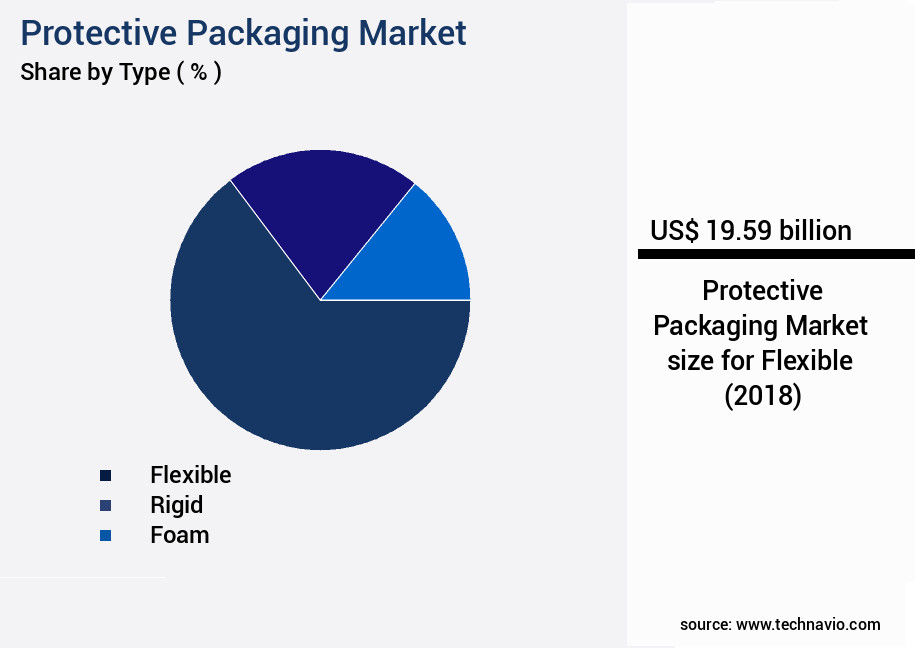
The Flexible segment was valued at USD 19.59 billion in 2018 and showed a gradual increase during the forecast period.
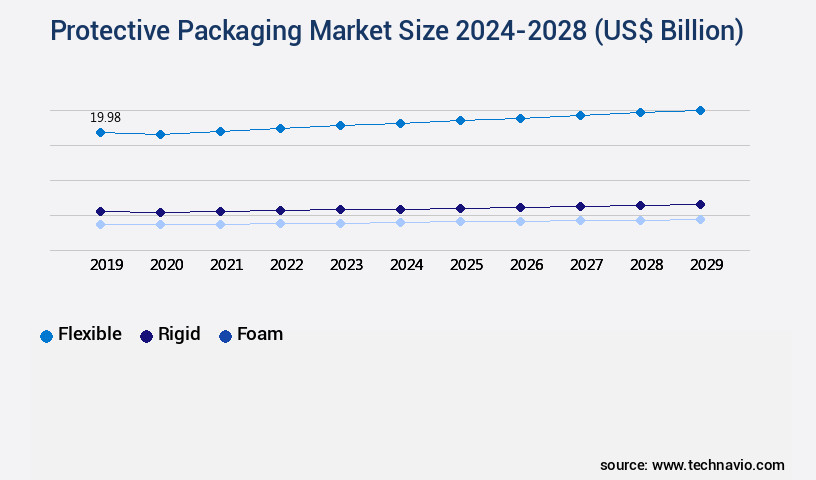
Request Free Sample
Regional Analysis
APAC is estimated to contribute 40% to the growth of the global market during the forecast period.Technavio's analysts have elaborately explained the regional trends and drivers that shape the market during the forecast period.
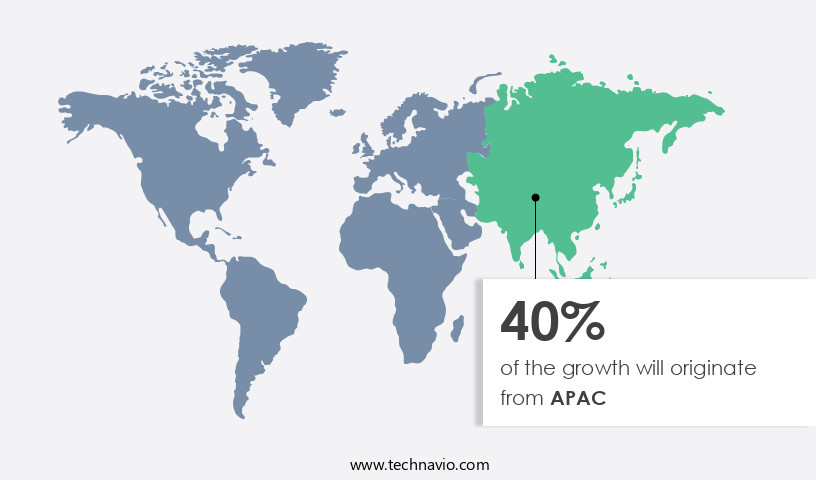
See How Protective Packaging Market Demand is Rising in APAC Request Free Sample
The market in APAC is experiencing consistent expansion, driven by the burgeoning e-commerce, FMCG, and personal care sectors. China and India are anticipated to significantly contribute to the industry's revenue growth due to the rapid expansion of their respective end-user industries. The e-commerce sectors in countries like China, India, and Japan are experiencing rapid growth, fueled by the increasing demand for a convenient shopping experience and the rising popularity of online retailers. With the surge in e-commerce, the importance of packaging in protecting products during transportation has become increasingly vital. In the APAC region, the retail and e-commerce sector is projected to grow steadily, with an estimated 15% of retail sales in the region expected to be generated online by 2025.
Additionally, the FMCG sector's growth is also contributing to the market's expansion, as companies focus on improving product safety and shelf life through innovative packaging solutions. The personal care sector is also witnessing growth, with a rising trend towards premiumization and increased focus on product protection during transportation and storage. Overall, the market in APAC is poised for significant growth, with estimates suggesting a 6% annual increase in demand for protective packaging solutions over the next five years. This growth is primarily driven by the expanding e-commerce and FMCG sectors, as well as the increasing focus on product protection and innovation in the personal care sector.
Market Dynamics
Our researchers analyzed the data with 2023 as the base year, along with the key drivers, trends, and challenges. A holistic analysis of drivers will help companies refine their marketing strategies to gain a competitive advantage.
Enhancing Business Performance through Innovative Protective Packaging Solutions the market in the US is witnessing significant advancements, driven by the growing demand for improved product protection, increased supply chain resilience, and heightened focus on sustainability. One area of innovation is the design of impact resistant corrugated packaging, which enhances product safety during transportation and reduces damage rates by up to 25%. Another critical aspect is the selection of high-performance cushioning materials, which can improve efficiency by 10-12% through faster packaging lines and reduced material waste. Automated packaging line optimization strategies further contribute to efficiency gains, ensuring consistent product throughput and minimizing downtime. Sustainability is a significant concern for businesses, leading to increased interest in sustainable packaging material lifecycle assessments. E-commerce packaging for fragile items is being redesigned using biodegradable materials, while temperature-sensitive pharmaceutical packaging solutions employ barrier films to maintain product integrity. In the electronics sector, vibration damping packaging is essential for sensitive components, reducing damage rates by nearly one-third. Custom molded foam inserts offer superior product protection, while pressure-sensitive adhesives ensure enhanced packaging seals. Packaging testing methodologies are essential for various product categories, ensuring compliance with industry standards and maintaining product quality. Barrier film selection for food packaging applications and design for recyclability in corrugated packaging systems further contribute to reduced environmental impact. Reusable packaging containers optimize logistics, reducing transportation costs and minimizing waste. RFID tracking in packaging enhances supply chain visibility, enabling real-time inventory management and improved order fulfillment. Intelligent packaging solutions maintain product freshness, extending shelf life and reducing waste. In conclusion, the market in the US is undergoing a transformation, driven by performance improvements, efficiency gains, compliance, and innovation. By embracing these advancements, businesses can enhance their operations, reduce costs, and improve their bottom line.
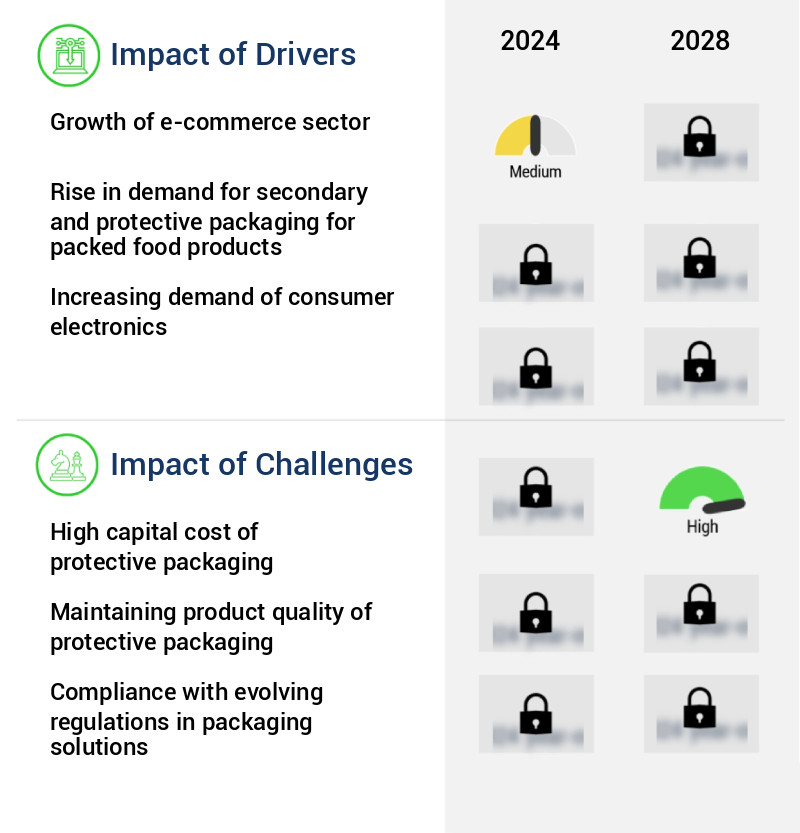
What are the key market drivers leading to the rise in the adoption of Protective Packaging Industry?
- The e-commerce sector's expansion serves as the primary catalyst for market growth.
- The market is experiencing significant expansion across various sectors, particularly in the e-commerce industry. This growth can be attributed to several factors, including the increasing number of tech-savvy consumers, rising Internet penetration, and the growing popularity of smartphones. The global market for protective packaging is thriving due to the surge in cross-border e-commerce sales. The e-commerce sector's rapid progression is driven by the convenience and flexibility it offers, making it an attractive alternative to traditional brick-and-mortar stores. The availability of multiple payment options, such as credit and debit cards, Internet banking, electronic wallets, and cash-on-delivery, has transformed purchasing patterns.
- Protective packaging plays a crucial role in ensuring the safe transportation of goods, particularly in the e-commerce sector. Its importance is underscored by the increasing number of international transactions, which require robust packaging solutions to protect products during transit. The market's continuous evolution is evident in the development of innovative materials and designs. For instance, the use of biodegradable and recycled materials is gaining traction due to growing environmental concerns. Additionally, the integration of advanced technologies, such as sensors and automation, is streamlining the production process and enhancing the overall value proposition.
- This growth is primarily driven by the e-commerce sector, which accounts for a significant share of the market. In conclusion, the market is a dynamic and evolving industry that plays a vital role in the e-commerce sector's growth. Its importance is underscored by the increasing number of international transactions and the need for robust packaging solutions to protect goods during transit. The market's continuous evolution is driven by factors such as technological advancements and growing environmental concerns.
What are the market trends shaping the Protective Packaging Industry?
- The emergence of new recycling techniques is a notable trend in the flexible packaging market. This innovation aims to address the growing concern for sustainable waste management solutions.
- The market is characterized by continuous evolution and innovation, driven by growing consumer demand for enhanced product protection and increasing environmental concerns. Companies and raw material suppliers are addressing the issue of non-reusable plastic packaging by introducing eco-friendly solutions and recycling programs. For instance, Materials Recovery for the Future (MRFF) was established in 2015 to facilitate the cost-effective and successful recycling and recovery of plastic materials throughout their lifecycle. Other initiatives like the Dow Energy Bag, Waste and Resource Action Program (WRAP), Plastic Industry Recycling Action Plan (PIRAP), and Material Recycling Facility are also contributing significantly to plastic waste recycling from flexible packaging.
- These initiatives aim to minimize the environmental impact of protective packaging while ensuring product safety and efficiency. The market's dynamics are influenced by various factors, including technological advancements, regulatory requirements, and consumer preferences. As the market continues to unfold, it is essential for businesses to stay informed about the latest trends and developments to maintain a competitive edge.
What challenges does the Protective Packaging Industry face during its growth?
- The protective packaging industry's growth is significantly impacted by the high capital costs associated with its implementation.
- Protective packaging is a vital component in various industries, ensuring the safe transportation and preservation of goods. The market for protective packaging is continually evolving, driven by increasing consumer expectations for product quality and safety, as well as regulatory requirements. High capital costs pose significant challenges for manufacturers, necessitating substantial investments in advanced manufacturing equipment, specialized materials, and efficient supply chain infrastructure. These expenses can be prohibitive for smaller players and startups seeking market entry. Moreover, the need to innovate and develop new packaging solutions to cater to evolving customer demands and regulatory requirements adds to the financial burden.
- Companies must allocate resources towards research and development to stay competitive, which can strain their budgets. Sustainability is another critical factor influencing the market. Adopting eco-friendly materials and investing in recycling infrastructure comes with high costs. However, the growing emphasis on sustainability and the potential for long-term cost savings make these investments increasingly attractive. The market's competitive landscape is diverse, with numerous players catering to various industries and applications. Market leaders invest heavily in research and development to offer innovative solutions and maintain a strong market presence. Despite the financial challenges, the market's continuous growth and evolving patterns underscore its importance in various industries.
Exclusive Customer Landscape
The protective packaging market forecasting report includes the adoption lifecycle of the market, covering from the innovator's stage to the laggard's stage. It focuses on adoption rates in different regions based on penetration. Furthermore, the protective packaging market report also includes key purchase criteria and drivers of price sensitivity to help companies evaluate and develop their market growth analysis strategies.
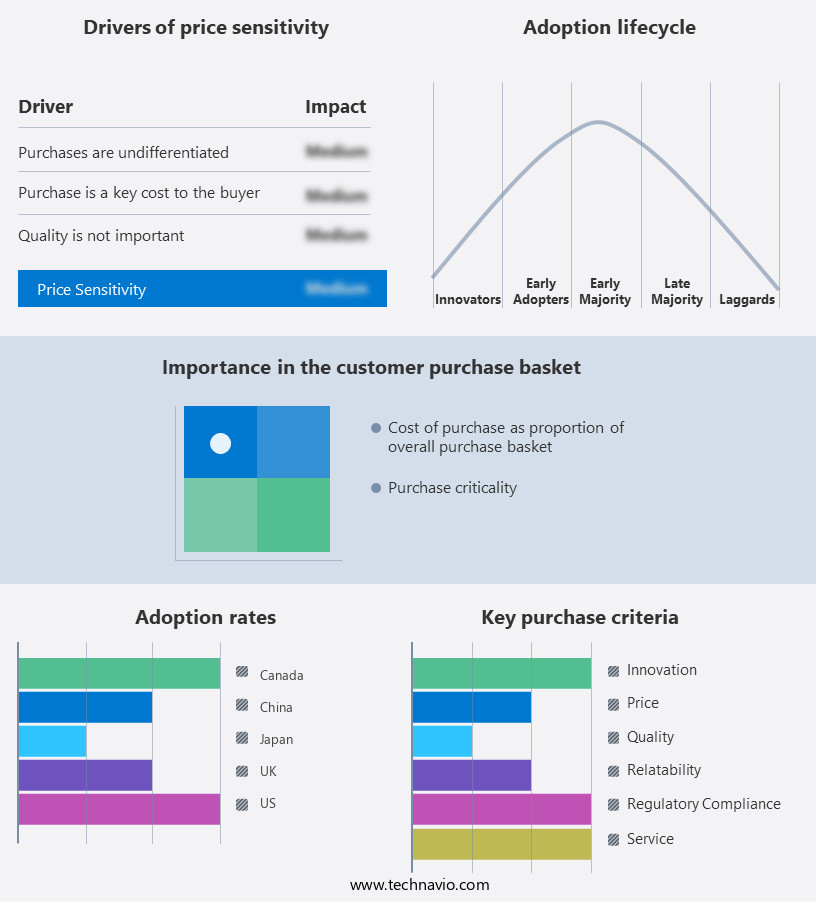
Customer Landscape of Protective Packaging Industry
Key Companies & Market Insights
Companies are implementing various strategies, such as strategic alliances, protective packaging market forecast, partnerships, mergers and acquisitions, geographical expansion, and product/service launches, to enhance their presence in the industry.
Berry Global Inc. - This company specializes in the production and supply of protective packaging solutions, including regular boxes, die-cut boxes, and insulated boxes, ensuring product safety and secure transportation.
The industry research and growth report includes detailed analyses of the competitive landscape of the market and information about key companies, including:
- Berry Global Inc.
- Cascades Inc.
- Crown Holdings Inc.
- Dow Inc.
- DS Smith Plc
- EcoEnclose
- Hanchett Paper Co.
- International Paper Co.
- Intertape Polymer Group Inc.
- Mondi Plc
- NEFAB GROUP
- Pregis LLC
- Ranpak Holdings Corp.
- Sealed Air Corp.
- Smurfit Kappa Group
- Sonoco Products Co.
- Storopack India Pvt. Ltd.
- Universal Protective Packaging Inc.
- WestRock Co.
- Winpak Ltd.
Qualitative and quantitative analysis of companies has been conducted to help clients understand the wider business environment as well as the strengths and weaknesses of key industry players. Data is qualitatively analyzed to categorize companies as pure play, category-focused, industry-focused, and diversified; it is quantitatively analyzed to categorize companies as dominant, leading, strong, tentative, and weak.
Recent Development and News in Protective Packaging Market
- In January 2024, Amcor, a global packaging company, announced the launch of its new product line, "Protect-Pak," an advanced protective packaging solution designed for the electronics industry. This innovation offers enhanced shock and vibration protection, reducing damages during transportation and handling (Amcor Press Release, 2024).
- In March 2024, Sealed Air and DHL Supply Chain signed a strategic partnership to develop and implement more sustainable protective packaging solutions across DHL's global network. This collaboration aims to reduce plastic usage and promote circular economy principles in the protective packaging industry (Sealed Air Press Release, 2024).
- In April 2025, Sonoco, a leading packaging company, completed the acquisition of TC Transcontinental's flexible packaging business for approximately USD1.3 billion. This acquisition significantly expands Sonoco's flexible packaging capabilities and strengthens its position in the market (Sonoco Press Release, 2025).
- In May 2025, the European Union approved new regulations on single-use plastics, including protective packaging, to reduce plastic waste and promote sustainable alternatives. Companies must comply with these regulations by 2027, driving the market towards eco-friendly protective packaging solutions (European Commission Press Release, 2025).
Research Analyst Overview
- The market encompasses a wide range of solutions designed to ensure product safety and integrity during transportation, storage, and distribution. This market continues to evolve, driven by advancements in technology and increasing demand for specialized packaging across various sectors. Compression strength and barrier properties are crucial aspects of protective packaging. Compression strength is essential for packaging that will be subjected to heavy loads or pressure, such as in material handling or logistics applications. Barrier films, including moisture and oxygen barrier films, play a significant role in climate control packaging for temperature-sensitive goods, pharmaceuticals, and food products. Packaging testing standards and lifecycle analysis are integral to the development and implementation of protective packaging solutions.
- These standards ensure that packaging meets specific requirements for various industries, such as pharmaceutical packaging and food packaging regulations. Lifecycle analysis helps optimize supply chain operations by assessing the environmental impact and cost-effectiveness of packaging throughout its entire lifecycle. Custom packaging solutions are increasingly popular in markets where product protection is paramount. These solutions cater to specific requirements, such as fragile goods, anti-static packaging, and vibration damping systems. Material handling equipment and packaging integrity monitoring systems further enhance the protective capabilities of these solutions. The market is expected to grow at a steady pace, with industry analysts projecting a 5% annual growth rate over the next five years.
- This growth is driven by the increasing importance of product protection, particularly in e-commerce and the pharmaceutical industry, as well as the ongoing development of innovative packaging technologies, such as protective cushioning foams, pressure-sensitive adhesives, and packaging design software. Drop testing procedures and impact resistance testing are essential for ensuring the protective capabilities of packaging solutions. These tests help evaluate the performance of packaging under various conditions, ensuring that it can withstand the rigors of transportation and handling. In conclusion, the market is a dynamic and evolving industry that plays a crucial role in ensuring product safety and integrity.
- Its applications span various sectors, from pharmaceuticals and food to e-commerce and logistics. The ongoing development of innovative packaging solutions, such as climate control packaging, barrier films, and custom packaging, continues to drive market growth.
Dive into Technavio's robust research methodology, blending expert interviews, extensive data synthesis, and validated models for unparalleled Protective Packaging Market insights. See full methodology.
|
Market Scope
|
|
Report Coverage
|
Details
|
|
Page number
|
168
|
|
Base year
|
2023
|
|
Historic period
|
2018-2022 |
|
Forecast period
|
2024-2028
|
|
Growth momentum & CAGR
|
Accelerate at a CAGR of 3.45%
|
|
Market growth 2024-2028
|
USD 6.08 billion
|
|
Market structure
|
Fragmented
|
|
YoY growth 2023-2024(%)
|
3.21
|
|
Key countries
|
China, US, Canada, UK, and Japan
|
|
Competitive landscape
|
Leading Companies, Market Positioning of Companies, Competitive Strategies, and Industry Risks
|
Request Free Sample
What are the Key Data Covered in this Protective Packaging Market Research and Growth Report?
- CAGR of the Protective Packaging industry during the forecast period
- Detailed information on factors that will drive the growth and forecasting between 2024 and 2028
- Precise estimation of the size of the market and its contribution of the industry in focus to the parent market
- Accurate predictions about upcoming growth and trends and changes in consumer behaviour
- Growth of the market across APAC, North America, Europe, Middle East and Africa, and South America
- Thorough analysis of the market's competitive landscape and detailed information about companies
- Comprehensive analysis of factors that will challenge the protective packaging market growth of industry companies
We can help! Our analysts can customize this protective packaging market research report to meet your requirements.
Get in touch







![]() Get the report (PDF) sent to your email within minutes.
Get the report (PDF) sent to your email within minutes.
Complimentary full Excel data with your report purchase.